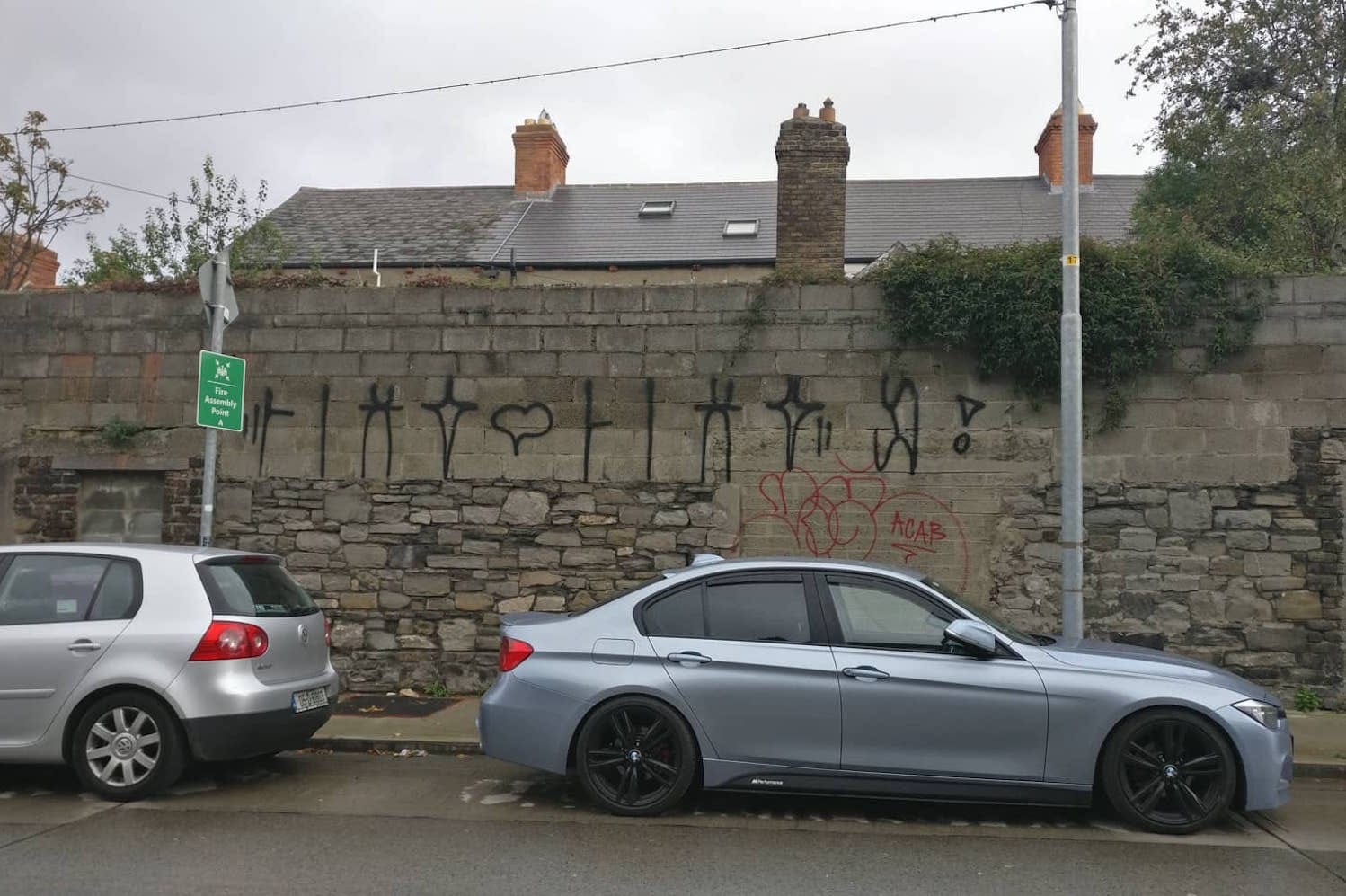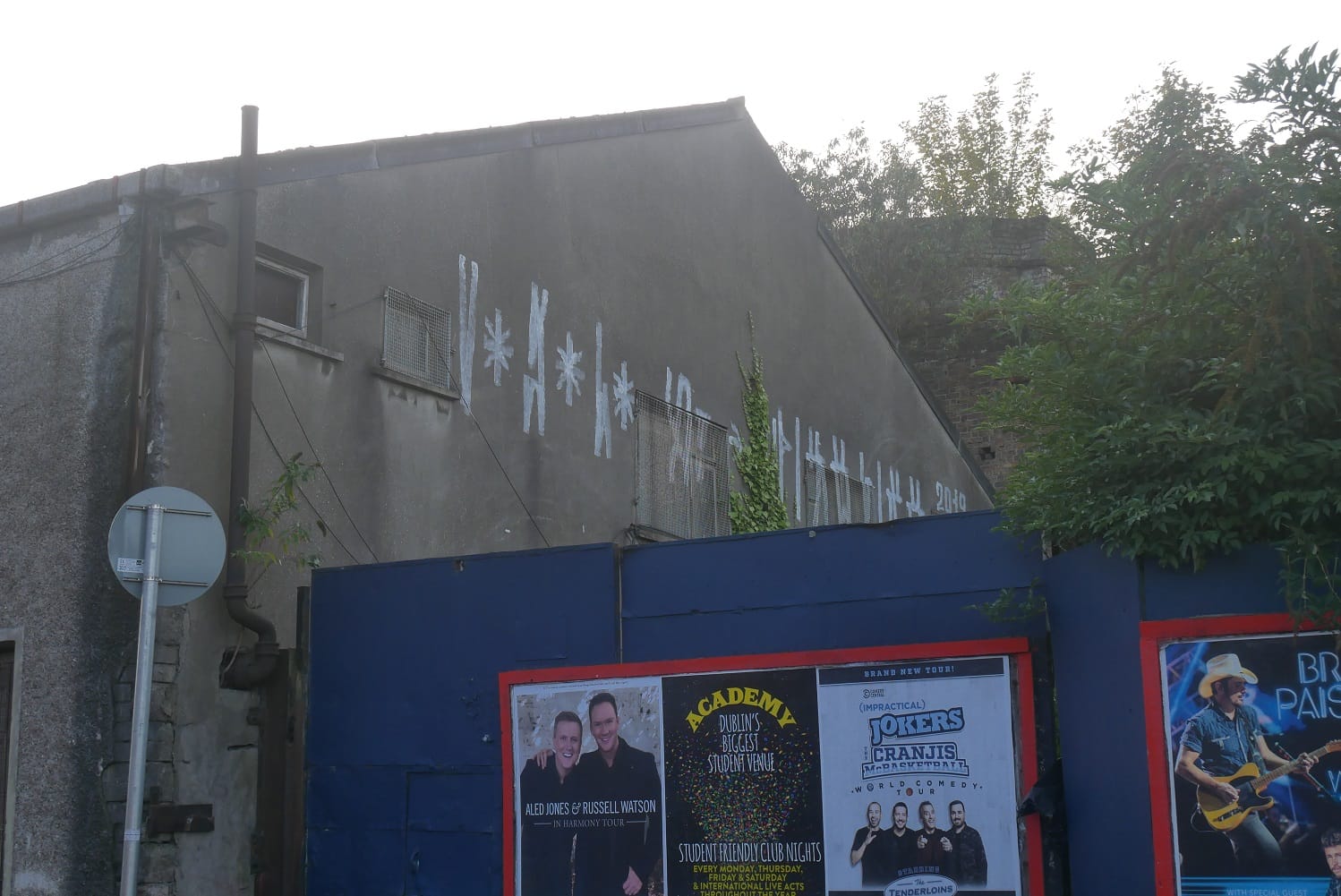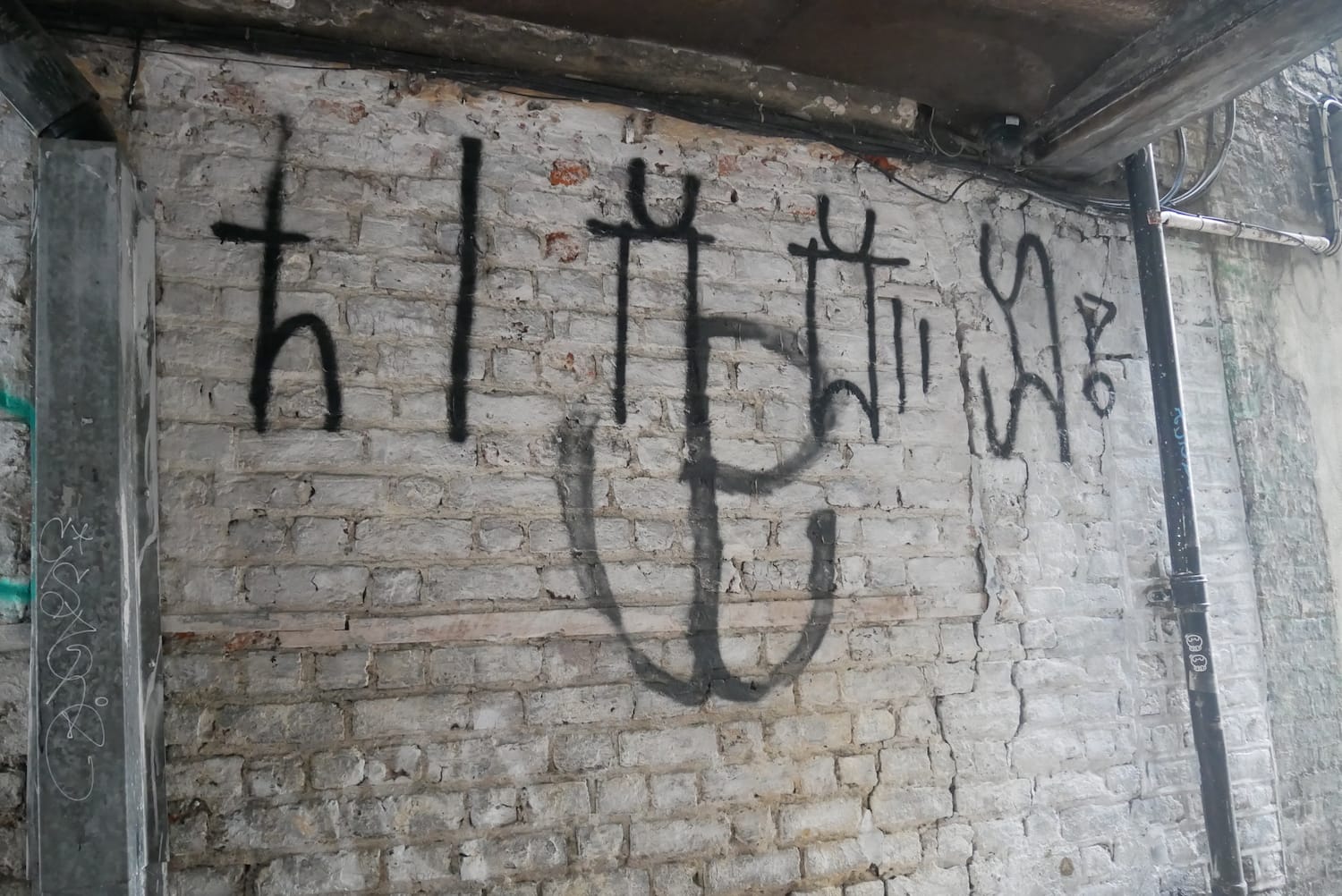What would become of the Civic Offices on Wood Quay if the council relocates?
After The Currency reported the idea of the council moving its HQ, councillors were talking about and thinking through the pros and cons and implications.
“Pixo”, which finds its origins in protests against urban inequality in Brazilian cities, has found a familiar canvas on derelict and vacant buildings around the Liberties and the Coombe.

Turn into Molyneux Yard off Thomas Street next to The Lab pizzeria, and you’ll see some spray-painted symbols in black across a wall.
They’re black, straight lines with curves and crosses or they have smaller lines parallel to them.
They look medieval if you were to hazard a guess. Are they runes? Alchemy-related symbols?
Anthony O’Brien Freeman, who does local tours around the neighbourhood, says they’ve appeared in other places too.
There’s some scrawled in black on a wall on Donore Avenue. There’s white symbols high up on a vacant building on the corner of Brabazon Place – visible, mostly, to those sitting on the top decks of buses travelling down Cork Street.
O’Brien Freeman got a clue to what they might be recently, he says. “A tourist on one of the tours said he had seen them on the top of buildings in Brazil.”
Turns out, they’re pichação, a type of graffiti you’ll see on street corners in São Paulo – and now in Dublin, too.
“This says ‘linda’,” says Fellipe Lopes, as he looks at photos of the Molyneux Lane pichação on Friday at Cafe Nero. It means “pretty” in Portuguese.
The symbols are actually stylised letters, he says. Like other tagging, they’re not always easy to read.
Lopes grew up in São Paulo, where pichação – also called “pixo” or “pixa” – originated. It’s spread to other cities too.
Pichar means “to tar” in Portuguese. The style got its name from the black spray-paint the writers use to tag.
“It’s vandalism and it’s anarchism. It’s to express some type of injustice,” says Lopes, a videographer and documentarian.

Pixadores often come from underprivileged areas, he says. Lopes himself grew up in Zona Leste, the east of the city, close to the favelas of São Paulo.
Pichação became popular in the late ’70s and early ’80s, he says. “We had a dictator (military) regime in Brazil. It was really strong,” he says. “We didn’t have any type of freedom or communication. So pixo style came from that type.”
The script is similar to what punk or metal bands sometimes use on their album covers, he says. “The roots are related to that music.”
“Loads of pixo that you find in São Paulo are anti-government,” says Lopes. “Messages will be along the lines of ‘end the government’ and ‘end the education system’.”
In 2017, Lopes exhibited [CentrøPixø], a photo documentary series of central São Paulo’s head-to-toe pixo, mounting photos in public spaces around the city.
São Paulo’s city centre has a scattering ofvacant buildings. Low-income workers and families are often pushed to the periphery of the city or choose to squat in high-rise vacant buildings.
With his exhibition, Lopes says he wanted to highlight empty buildings in São Paulo as much as the pixo that covers them.
“Every single wall, every single building, any surface you can imagine is covered in pixo in the centre of the city,” he says. Pixo is the consequence of the government not investing in the city, he says.
Tagging a centralised public location breaks down that marginalisation, says Jonah Mantell, by email.
It brings a sense of power and acknowledgement, “even if it’s somewhat anonymous”, says Mantell, who wrote a research paper on pixo while living in São Paulo in 2014.
“The average person has no idea what a pixo tag says,” Mantell says. “They just see it and know how they feel about it. Seeing it is all that matters.”
But, that doesn’t mean pixadores’ sole aim is to fight marginalisation. The adrenaline rush of scaling a building and leaving your tag is a big part of it too, says Mantell. For many pixadores, location is everything.
The idea of pixo as protest is “simply the understanding of pixação from a handful of educated, media-centred pixadores and the mainstream media”, he wrote in his 2014 paper.

If pixo is appearing in the city and it’s being done by Brazilians it means they have something to say, says Lopes. “The students are struggling.”
“They pay expensive rent for horrible rooms, 10 people in a room,” he says. “They are schemed by the schools.”
There were 13,640 Brazilians counted in Ireland during the 2016 census. Most of these (8,685) were living in Dublin and its suburbs, and a third were students.
“I suppose if it were going to go up anywhere, the Liberties would be the place I’d expect it,” says Adam Nealan, on Friday evening.
Strolling down Donore Avenue towards Cork Street, he says he “never noticed” the graffiti before on the wall across from St Teresa’s Gardens.
“A lot of people are angry about hotels built all over the place,” he says.
Says Nealan: “I think people around here would be pretty pissed with the government.”
Standing by the flats, Tommy Garland says it’s not his first time seeing pichação. “I guess it’s like most street art, usually kind of cryptic and vague.”
“I think most graffiti has a hidden meaning. That’s what it’s about. That’s why most people enjoy it.”
No pixadores wanted to talk on the record. In Brazil, retribution for tagging has in the past been brutal.
“Traditionally pixadores had to remain anonymous because of legality and a fear of police,” says Mantell, who wrote the research paper. But he says this is changing.
Says Lopes, who did the photo documentary: “Loads of things can happen if you are caught doing pixo. Unfortunately if you type on Google, you can see people got killed by cops.”
Lopes says he showed his exhibition in public spaces in São Paulo, like Franklin Roosevelt Square, back in 2017.
He printed the images of 10-storey buildings covered with metre-long columns and installed them in public places, sometimes getting hassle from the police.

Mantell says that other types of graffiti and pixo are pitted against each other
“Pichação is criminalized in Brazil,” he says. “There’s a weird grey legal area when it comes to street art and as a result, some street art is allowed and some is not.”
What’s acceptable in Brazil is grafite: “traditional form of graffiti, the mainstream and colorful style of street art,” wrote Mantell in his paper.
In 2009, the Brazilian government passed a law making street art and graffiti legal if done with the consent of building owners. It makes a distinction between tagging “the pixo” and grafite or graffiti.
In contrast to pixo, grafite is a huge tourist draw to São Paulo, he says. “Pretty much everyone (police included) agrees it’s a positive aspect of the city, both as a cultural export and source of revenue.”
[UPDATE: This article was updated at 19:00 on 9 October to remove all comments from an artist who decided he no longer wanted them included, and to clarify that Lopes did not “blow up” his images, he simply printed them.]